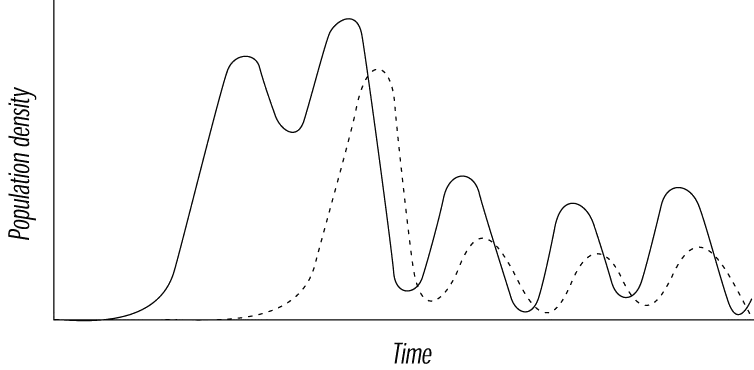Cactoblastis cactorum and Opuntia stricta
- an Analysis of Polulation Ecology
Control of prickly pear, Opuntia stricta, by the moth
Cactoblastis cactorum
was one of the most successful examples of biological control of weeds (Dodd
1940). Numbers of the biological control agent (dashed line) and the weed
(solid line) followed
the pattern shown in the Figure below.
Change in population density of an organism after
introduction into an environment with a mean carrying capacity of K.

Prickly pear infestation increased rapidly in Australia from five
million hectares in 1905 to 25 million hectares in 1925, when it had
occupied most of the area in which conditions for its growth were
favourable. It was present at high densities over about half its range.
The prickly pear was probably approaching the carrying capacity of the
Australian environment.
Following release in 1926, numbers of C. cactorum increased rapidly. Feeding by the larvae, accompanied by microbial rots, destroyed most, but not all, plants by 1934. Huge numbers of larvae starved to death. The insect population exceeded the carrying capacity of the environment and experienced massive density-related mortality. Surviving parts of plants were able to
re-grow while insect numbers were low, but the moth population again increased and attacked the prickly pear. By 1939 the infestation of prickly pear had been reduced by over 99% in
Queensland.
Viewed on an Australia-wide scale, the system has now settled to an equilibrium situation with low densities of prickly pear and
C. cactorum. However, the 'equilibrium' densities of plant and insect vary with weather, climate and region.
In southern areas where C. cactorum populations are limited by temperature, prickly pear survives at higher densities than in
Queensland. During droughts the prickly pear population at the arid western limit to its range may die back. In more favourable areas the prickly pear continues to grow during a drought, but plants growing under water stress are much less suitable for survival of larvae
(White 1981). The effect of plant quality in reducing
C. cactorum populations may be magnified by high temperature-induced mortality of larvae. Thus prickly pear density may increase and
C. cactorum populations may decrease until wetter seasons prevail.
On soil types with low nutrition, prickly pear is resistant to attack by
C. cactorum
- the physiology of the plant is modified to produce highly mucilaginous sap in which larvae drown. Application of nitrogen fertilizer results in normal plant growth, making these plants susceptible to
C. cactorum.
At a local level, populations of plant and insect may fluctuate widely. Prickly pears may be carried by flood as vegetative pieces or by birds or other animals as seed a long way from the original prickly pear source and C.
cactorum infestation. A plant and its progeny may develop for a long
time into a locally dense infestation before a moth finds the infestation,
lays eggs and begins destruction of the infestation. This cycle of local
increases in plant density followed by rapid increase in insect density
and destruction of the plants occurs in many places and at many times.
[ Back ] [ Next ]
Graham White

